Cézanne to Picasso: Ambroise Vollard, Patron of the Avant-Garde, at the Metropolitan Museum of Art (NYC) September 14, 2006 – January 7, 2007,the Art Institute of Chicago,February 17—May 12, 2007, Musée d’Orsay, Paris : June 19–September 16, 2007; was the first comprehensive exhibition devoted to Ambroise Vollard (1866-1939) – the pioneer dealer, patron, and publisher who played a key role in promoting and shaping the careers of many of the leading artists during the late 19th and early 20th centuries. One hundred paintings as well as dozens of ceramics, sculpture, prints, and livres d'artistes commissioned and published by Vollard, from his appearance on the Paris art scene in the mid-1890s to his death in 1939, will comprise the exhibition.
Image may be NSFW.
Clik here to view.

Cézanne to Picasso: Ambroise Vollard, Patron of the Avant-Garde featured works by Bonnard, Cézanne, Degas, Derain, Gauguin, Van Gogh, Maillol, Matisse, Picasso, Redon, Renoir, Rouault, Rousseau, Vlaminck, Vuillard, and others. Highlights included six paintings from Vollard's landmark 1895 Cézanne exhibition; a never-before-reassembled triptych from his 1896-97 Van Gogh retrospective; the masterpiece
Image may be NSFW.
Clik here to view.

Where Do We Come From? What Are We? Where Are We Going? from his 1898 Gauguin exhibition;
paintings from Picasso's first French exhibition (1901) and Matisse's first solo exhibition (1904); and three pictures from Derain's London series, painted in 1906-1907 at Vollard's suggestion. Also on view were numerous portraits of Vollard by leading artists, among them Cézanne, Bonnard, Renoir, and Picasso.
"Vollard's genius lay in his ability to identify undiscovered talent," commented Philippe de Montebello, Director of The Metropolitan Museum of Art. "That Cézanne, Gauguin, Van Gogh, and many others are household names today is in large part due to Vollard's early promotion of their work. It is remarkable that there has never before been a substantial exhibition devoted to the extraordinary scope of Vollard's activities. This international presentation, which premieres at the Metropolitan, is the result of an impressive, sustained effort on the part of a team of curators at the Metropolitan as well as in Chicago, London, and Paris."
Ambroise Vollard was a legend in his own lifetime. He arrived in Paris from the remote Ile-de-la-Réunion in 1887 and made his reputation at the age of 29 with a Cézanne retrospective that was possibly the most important exhibition of that decade. Cézanne's work was virtually unknown in Paris at the time, and Vollard took a significant financial risk in showcasing the 150 paintings that he displayed. The effort was rewarded, however, when Vollard sold many of the works from the show and Cézanne's place in the pantheon of modern art was established. Soon he became the leading contemporary art dealer of his generation and a major player in the history of modern art. Vollard was the principal dealer of Paul Cézanne, Paul Gauguin, and a number of Fauve artists, and he lent early support to the Nabis, Henri Matisse, and Pablo Picasso. He had a unique – some thought eccentric – approach to selling art, frequently dozing in his gallery, making a point of not showing his clients what they asked to see, and concealing most of his paintings behind a divider at the back of his shop.
Cézanne to Picasso featured individual rooms dedicated to Cézanne, Gauguin, and Van Gogh. Included were six of the paintings that Vollard displayed in his groundbreaking Cézanne exhibition of November 1895. In 1898 the dealer hosted a small exhibition of Gauguin's Tahitian-period paintings – the centerpiece of that show, Where Do We Come From? What Are We? Where Are We Going? (Museum of Fine Arts, Boston) (above) highlighted the New York and Chicago venues of Cézanne to Picasso.
Another highlight was three Van Gogh paintings that Vollard seems to have presented as a triptych in his 1896-97 Van Gogh exhibition:
Image may be NSFW.
Clik here to view.

Banks of the Seine with Pont de Clichy in the Spring (Dallas Museum of Art),
Image may be NSFW.
Clik here to view.

Fishing in Spring, The Pont de Clichy (Asnières) (Art Institute of Chicago),
Image may be NSFW.
Clik here to view.
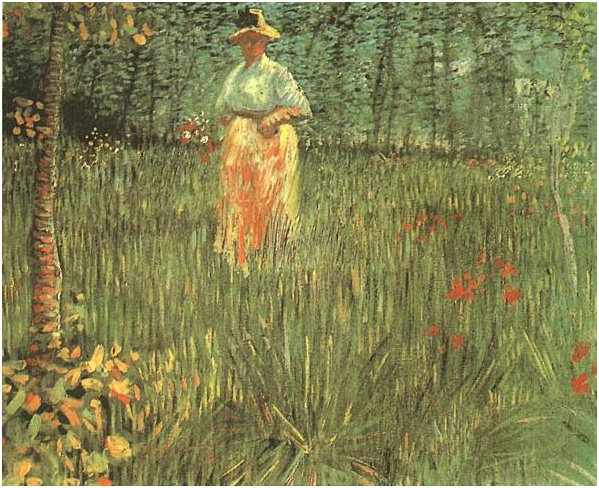
and Woman in a Garden (private collection).
The three paintings date to 1887, share almost identical dimensions, and feature painted red borders. Vollard recalled that, early on, "even the boldest were unable to stomach [Van Gogh's] paintings."
Other rooms of Cézanne to Picasso highlighted the work of groups of artists, such as the Nabis and Fauves. Beginning in the mid-1890s, Vollard championed the artists known collectively as the Nabis – he purchased their pictures, commissioned their prints, and held two major group exhibitions of their work at his rue Laffitte gallery in 1897 and 1898. Cézanne to Picasso featured paintings by Bonnard, Denis, Roussel, and Vuillard, as well as their lithograph albums, livres d'artiste, and Bonnard's bronze table sculpture, Spring Frolic (The Terrasse Children) (Art Institute of Chicago), which was the subject of an exhibition at Vollard's gallery in 1902.
The Fauve room displayed works made by some of the artists who exhibited together in the famous 1905 Salon d'automne. Included were paintings from Matisse's first solo exhibition held at Vollard's in June 1904 and three of Derain's paintings of the Thames River, which Vollard commissioned ca. 1906 after seeing Monet's paintings of the same subject. Also featured in this gallery were colorful plates and vases that the Fauves produced in conjunction with the master ceramicist André Metthey at Vollard's request.
Vollard's interest in publishing spanned his career and he played a vital role in the original printmaking revolution at the end of the 19th century. He was responsible for a number of celebrated albums of original lithographs – by such artists as Bonnard, Denis, Roussel, and Vuillard – and his enthusiasm for publishing extended to the production of luxury livres d'artiste as well as monographs on Cézanne, Degas, and Renoir and his own autobiography in 1936. One room of the exhibition was devoted exclusively to these books and prints, including four Nabi albums of color lithographs. Vollard's personal copy of Oeuvres de François Villon, heightened in gouache by Emile Bernard, will also be on view, as well as a group of never before exhibited copper plates and proofs for Cirque de l'étoile filante, annotated with color notes by Georges Rouault (Fondation Georges Rouault, Paris).
Picasso once remarked that Vollard's likeness was painted more often than the world's most beautiful woman, and another highlight of Cézanne to Picasso was a room of portraits of Vollard by leading artists, among them
Image may be NSFW.
Clik here to view.

Cézanne's early vision of him holding a book (Petit Palais, Musée des Beaux-Arts de la Ville de Paris),
Image may be NSFW.
Clik here to view.

Renoir's interpretation of him as a toreador (Nippon Television Network Corporation, Tokyo),
Image may be NSFW.
Clik here to view.

Image may be NSFW.
Clik here to view.
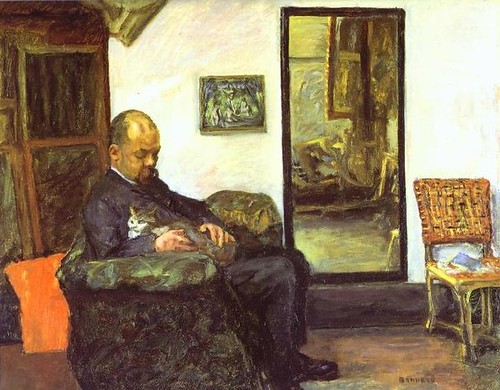
and Bonnard's views of him with his beloved cat (Petit Palais and Kunsthaus Zürich).
Also in the exhibition was Bonnard's painting of Vollard and his guests dining in the dealer's famous "cave," the humid cellar beneath his gallery, where "tout Paris" mingled. The painting (private collection) has rarely been seen.
The exhibition concluded with a gallery devoted to the work of Pablo Picasso, who had his first Parisian exhibition in 1901 at Vollard's gallery. Eight paintings from that exhibition were on display, including
Image may be NSFW.
Clik here to view.

a portrait of the author of the catalogue preface, Gustave Coquiot (Centre Pompidou, Paris).
Vollard bought Picasso's Blue Period and Rose Period paintings, and new research has shown that he purchased Cubist paintings as well, among them Picasso's
Image may be NSFW.
Clik here to view.

memorable portrait of the narcoleptic dealer, painted in a Cubist style (Pushkin State Museum of Fine Arts, Moscow).
The one hundred etchings that compose Picasso's Suite Vollard ended the exhibition:
Image may be NSFW.
Clik here to view.

Image may be NSFW.
Clik here to view.

Image may be NSFW.
Clik here to view.

Image may be NSFW.
Clik here to view.

Every work chosen for Cézanne to Picasso passed through Vollard's hands, whether it was commissioned, exhibited, or owned by him. Many of the loans have additional significance. For example, some of the paintings on display were sold by Vollard to other artists, such as the Cézannes acquired by Matisse
Image may be NSFW.
Clik here to view.

(Three Bathers, Petit Palais),
Monet
Image may be NSFW.
Clik here to view.

(Bathers, Saint Louis Art Museum,
Image may be NSFW.
Clik here to view.
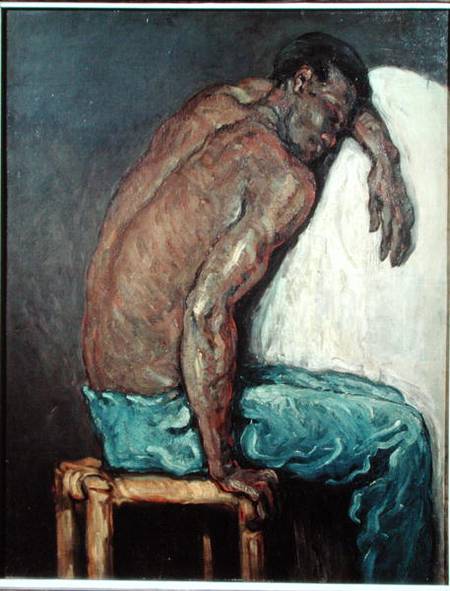
and Negro Scipion, Museu de Arte de São Paulo),
and Renoir
Image may be NSFW.
Clik here to view.
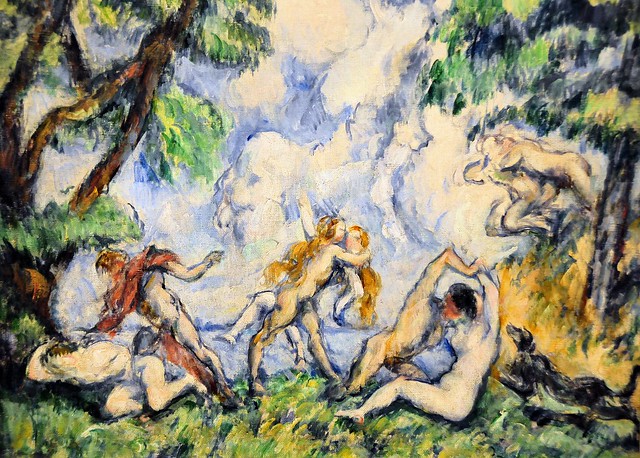
(The Battle of Love, National Gallery of Art, Washington, D.C.)
and the Rousseau purchased by Picasso
Image may be NSFW.
Clik here to view.
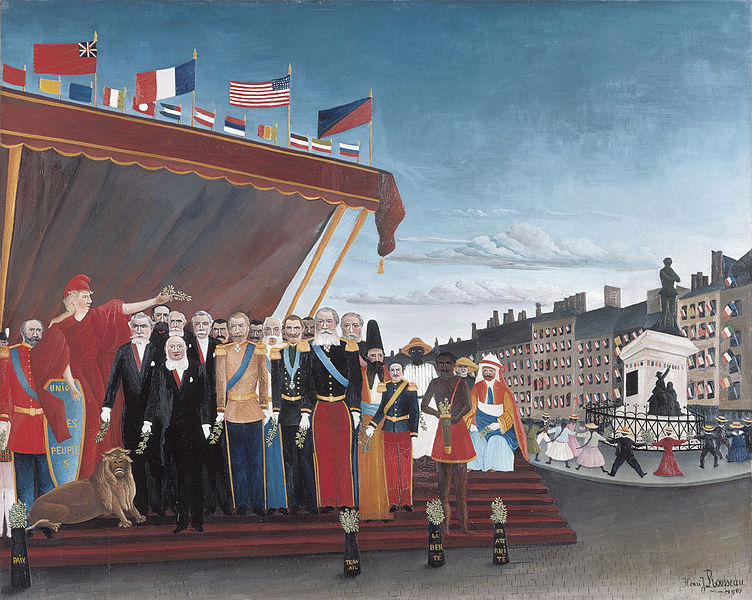
(The Representatives of Foreign Powers Coming to Greet the Republic as a Sign of Peace, Musée Picasso, Paris).
A secondary theme of the exhibition was Vollard's influence in developing collections of modern art, and consequently the curators have included paintings that Vollard sold to Louisine and H. O. Havemeyer, Cornelis Hoogendijk, Vincenc Kramár, Ivan Morozov, Karl Ernst Osthaus, Auguste Pellerin, Sergei Shchukin, and John Quinn, among others.
The exhibition was organized by Gary Tinterow, Engelhard Curator in Charge, and Rebecca Rabinow, Associate Curator, both of the Department of Nineteenth-Century, Modern, and Contemporary Art at The Metropolitan Museum of Art; Douglas Druick and Gloria Groom at the Art Institute of Chicago; Ann Dumas, a London-based art historian; and Anne Roquebert at the Musée d'Orsay.
Image may be NSFW.
Clik here to view.
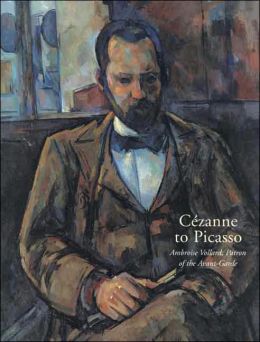
A 460-page, fully illustrated scholarly catalogue accompanied the exhibition. Twenty-two essays examined Vollard's career and expertise in the art market, his relationships with individual artists and collectors, and the wealth of previously unpublished material from the newly available archive of Vollard's documents and from archives of the artists he represented.
Great commentary here (images added):
I’ve been through the show Cézanne to Picasso: Ambroise Vollard, Patron of the Avant-Garde (which opens o the public tomorrow) and it is amazing, a must see. It is a great collection of masterworks such as...
Image may be NSFW.
Clik here to view.
the Art Institute’s Old Guitarist by Pablo Picasso.
There are countless major works,
Image may be NSFW.
Clik here to view.
A Modern Olympia, along with Paul Cézanne’s other motifs of bathers, apples, and mountain views. Gauguin’s Breton and Tahiti periods, Picasso’s birth of cubism, Aritside Maillol’s voluptuous nudes, the Nabis, the Fauves and more. It is really a rare opportunity to see all this in one place...
With masters like these, we have cultural amnesia. We take for granted that these pictures are masterpieces and that they all belong in museums. When in reality, they started out hated and unpopular. In hindsight, we read the story backwards, beginning with the knowledge that these are all great artists; their stories myths that we know will have happy endings. But Vollard and visionaries like him were essential to getting these artists’ work out to the public. Art is not a solitary endeavor, it takes a structure. Artists, collectors, dealers, institutions all play a part in bringing work to the viewer. Ambroise Vollard is one of the dealers that provided a forum for artists to communicate. Vollard was not just someone peddling paintings, he maintained a dialogue with his artists, introduced them to one another, supported them, and encouraged them to try new things. Vollard often took risks, at significant financial losses, especially in terms of his prodigious output of publications, including prints and books. This is what makes the exhibition so interesting. It tells more of the story of Modern Art than just famous painters hanging out together; it establishes the roles so many different characters played in each other’s lives.
From another excellent review, well worth reading in its entirety:
This exhibition's collection of works by Gauguin is most impressive. An archetypal dropout, he left the world of high finance and bourgeois security to begin a career in painting. Part-Peruvian, he soon began to search for his primitive roots in Brittany and continued his mission in exotic Tahiti. In the provocative
Image may be NSFW.
Clik here to view.
Image © Albright-Knox Art Gallery, Buffalo, New York; Used with permission
Paul Gauguin (French, 1848-1903)
Manao tupapau (Spirit of the
Dead Watching), 1892
Oil on burlap mounted on canvas
28 1/2 x 36 3/8 in. (72.4 x 92.4 cm)
A. Conger Goodyear Collection, 1965
1965:1
© Albright-Knox Art Gallery, Buffalo, New York
Spirits of the Dead Watching (1892), Gauguin chipped below the surface, revealing the psychological fears of an adolescent girl at the moment of her sexual awakening and the realization of her own mortality.
Included in the show are some woodcuts, decorative pots and stoneware by the artist.
Image may be NSFW.
Clik here to view.
The Nightmare (ca. 1899-1900)
Image may be NSFW.
Clik here to view.
and Crouching Tahitian Woman (1899)
(images added) are two startling drawings that give the viewer the opportunity to witness Gauguin's creative process in his innovative technique of transfer drawing.



,_1899%E2%80%931900_monotype.jpg)
